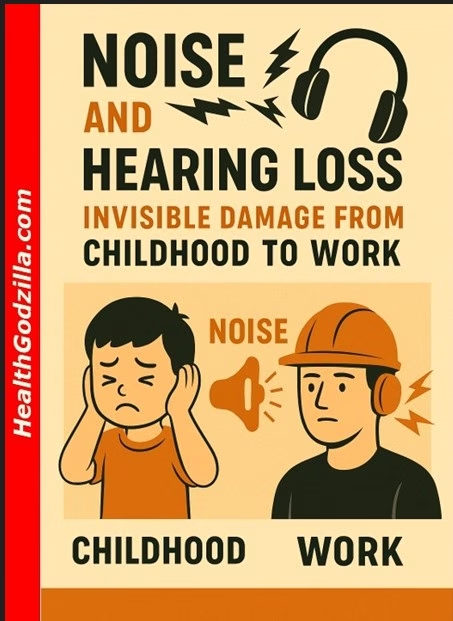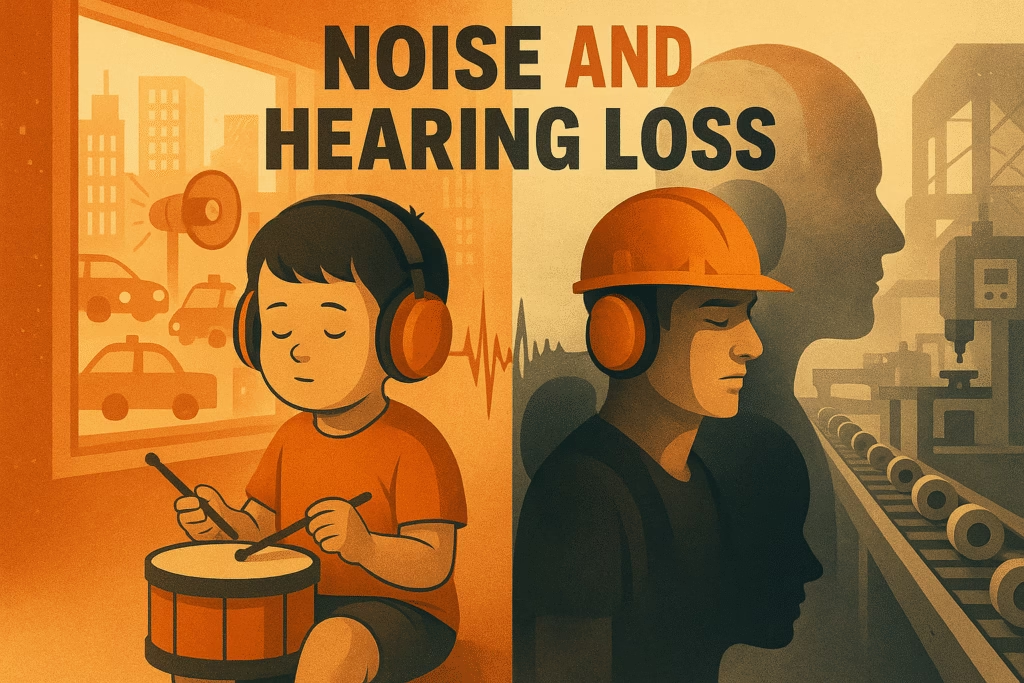
Noise and hearing loss are not sudden storms; rather, they are slow erasers—scraping away the edges of life’s sounds, syllable by syllable. For instance, the lullaby you barely heard as a child, the whispered joke in a factory break room, and the birdcall behind the morning traffic—all begin to fade before we even realize silence has crept in. Moreover, from toy guns to turbines, earbuds to engine rooms, the damage starts early, runs deep, and too often goes unnoticed. Yet, what if the loudest wounds are the ones we never hear?
1. The Forgotten Whisper
The world is not too loud for you, little one—
But the world forgets to whisper.
Before a child learns the lullaby of language, a hairdryer hums at 90 decibels. Similarly, before a worker hears their first wage, a punch press hammers at 110. Furthermore, somewhere in between, a silence begins—not the kind that soothes, but the kind that swells.
Noise and hearing loss don’t arrive like thunder; instead, they appear like mist. Indeed, they are invisible, persistent, and clinging to the edges of schoolyards, headphones, assembly lines, and crowded subways. Across five continents and countless machines, a new form of deafness is growing—unnoticed, misunderstood, and often unspoken.
2. Sound as a Shape-Shifter: What Science Says
Sound, at its core, is chemistry in motion—specifically, air molecules colliding in waves, then pushing pressure into the tender coils of the inner ear. However, these waves can, in some instances, become weapons.
Moreover, the cochlea—shaped like a sea snail—is lined with hair cells as fragile as frost. Consequently, when exposed to sustained or intense noise—anything above 70 dBA, and especially bursts exceeding 120 dBC—these cells bend, break, and ultimately die. Tragically, they do not regenerate.
Science draws the pattern clearly:
- The 4 kHz dip—the early signature of noise-induced hearing loss (NIHL)
- Tinnitus—a phantom ringing where silence once lived
- Recruitment—where soft sounds are lost, and loud ones feel unbearable
- Sensorineural decline—gradual, permanent, often unnoticed until it begins to steal relationships and livelihood
From NIH to ILO, from Health Canada to Johns Hopkins, every signal converges:
Noise changes not just the ear, but the mind, memory, and meaning.
3. From Cradle to Conveyor Belt
Children do not choose their exposures; thus, their worlds are filled with unintended harm. For example, toy sirens, loud TVs, birthday parties near speakers, and even well-meant lullabies delivered through earbuds contribute to this issue. By adolescence, many already show signs of auditory damage. This is particularly evident in urban areas and low-income housing, where noise is both closer and more constant.
Then begins the second half of the story: the workplace.
- Textile workers surrounded by rhythmic roar
- Farmers near machinery without mufflers
- Call center agents tethered to headsets for 10 hours straight
- Construction crews, printing press workers, and even teachers in echoic classrooms
The ILO outlines four phases of NIHL:
- Temporary fullness and ringing
- Latent shift at 4 kHz
- Difficulty in conversations, especially in background noise
- Complete disconnection—social, emotional, and economic
And still, no scream is heard. Only the slow drowning of sound.

4. The Quiet Consequences
What is lost in hearing is not just volume; rather, it is intimacy. Conversations become guesswork, and laughter fades. Lovers grow distant. Teachers seem unclear. Although the television grows louder, the message remains blurry.
In children, hearing loss not only delays the development of language but also stunts emotional growth and self-expression. Meanwhile, in adults, it brings loneliness, depression, fatigue, and misjudged intelligence.
A missed whisper becomes a missed warning. A missed word, a missed connection. In the end, in economies built on communication—where labor and language are currency—hearing loss becomes poverty’s silent partner.
5. The Science of Prevention
This pain is not inevitable.
- Engineering controls can silence machines without silencing production.
- Shift rotations reduce cumulative exposure.
- Sound mapping and monitoring reveal where ears are at risk.
- Audiometric testing tracks decline before the worker forgets their child’s voice.
- Substitution and elimination—not just earplugs—must be the first line.
Even chemical exposure—like toluene, styrene, or carbon disulfide—can worsen noise’s impact, as revealed in synergistic research from the ILO and WHO.
And yet, too often, PPE is handed out like an apology, not a plan.
Protection begins not in the ear canal—but in the blueprint, the budget, and the belief that silence should be sacred.
6. The Noise We Leave Behind
Noise-induced hearing loss is the only entirely preventable form of hearing loss. However, the damage continues—across nations, ages, and industries—because we mistakenly equate volume with vitality and endurance with safety.
But what if we listened differently?
What if, instead of shouting, our machines murmured?
Could we, perhaps, teach children to recognize dangerous decibels just as they do fire alarms?
And imagine this—if the last thing a worker heard on their shift wasn’t a ringing in their ears, but a song of protection.
“Maybe we cannot reclaim the sounds already lost—
but we can protect the sounds yet unborn.”
🍂 Hello, Artista

Artista sat on the floor beside Whitee, who twitched each time the blender roared.
“She hates the hum,” Artista whispered, stroking the rabbit’s back. “It doesn’t sound like food—it sounds like something coming undone.”
Meanwhile, Organum laughed, though not unkindly. “In Boston, the trains speak louder than the teachers. As a result, my students often don’t know what they missed until the test.”
As they sat together in that small kitchen, a soft silence enveloped them.
“Maybe,” Artista mused, “the world doesn’t need to be quieter. Rather, it just needs to learn to whisper again.”
🌠 Author’s Reflection
I was not alone when I wrote this; rather, others spoke, and I listened.
A technician once told me he had lost the ability to hear birds.
A mother watched her child fall behind in school—and shared her sorrow.
And a worker believed the ringing would fade—but it never did.
In addition, organizations like the ILO, the NIH, Health Canada, and Hopkins added their voices.
Yet, the loudest voice was this—
“I sang a song of flowers while sitting in the fire of hell.”
—Kazi Nazrul Islam, Biddrohi
I carry that flame, not to burn—but to illuminate.
So others can hear the whisper before it fades.
—Jamee
🌼 Articles You May Like
From metal minds to stardust thoughts—more journeys await:
- How Labels Affect Self-Esteem: Are we truly what they say we are? A lakeside conversation of names, masks, and the quiet rebellion of the soul.
- Zinc Exposure at Work: Two Faces and the Cost Behind the Shine A tale of shimmer and shadow—where workplace metals whisper of health and hazard.
- Impact of Air Pollution on Plants: Leaves Bear Scars of Our Progress The green lungs of cities speak—chloroplasts and silence battling the unseen.
Curated with stardust by Organum & Artista under a sky full of questions.
📚 Principal Sources
- Niu, S., Colosio, C., Carugno, M., & Adisesh, A. (Eds.). (2022). Diagnostic and exposure criteria for occupational diseases: Guidance notes for diagnosis and prevention of the diseases in the ILO list of occupational diseases (Revised 2010). International Labour Office.
- National Institute on Deafness and Other Communication Disorders. (n.d.). NIDCD fact sheet | Hearing and balance: Noise-induced hearing loss. U.S. Department of Health and Human Services, National Institutes of Health.
- Health Canada. (n.d.). Noise and sound: Hearing loss and tinnitus. Government of Canada.
- Johns Hopkins Medicine. (n.d.). Noise-induced hearing loss in children. The Johns Hopkins University, The Johns Hopkins Hospital, and Johns Hopkins Health System.
- Ismail, A. F., Daud, A., Ismail, Z., & Abdullah, B. (2013). Noise-induced hearing loss among quarry workers in a north-eastern state of Malaysia: A study on knowledge, attitude and practice. Oman Medical Journal, 28(5), 331–336. Available via National Library of Medicine: https://pmc.ncbi.nlm.nih.gov/articles/PMC3769125/
Relevant chapters and sections were interpreted through a narrative lens rather than cited academically.

Leave a Reply